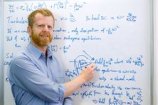Overview
Click this link to expand the page to include a web form.
Via web form you obtain the spatial discretisation of up to
three coupled dynamical partial differential
equation (PDE) using dynamical systems
theory. The technique not only ensures consistency of the
discretisation, but remarkably theory ensures the
exponentially quick relevance of the discretisation at
finite grid spacing \(h\). Theory also suggests the
numerical disretisation should have good stability
properties on a coarse spatial grid.
I use a slow mode coupled complex Ginzburg--Landau equation
as an example (from Ispen and
Sorensen 1999 ):
\[
\frac{\partial u}{\partial t} =ru -(1+ia)|u|^2u
+\frac{\partial^2u}{\partial x^2}
+(1-ib)uw\,,
\]
\[
3\frac{\partial w}{\partial t} =-w -|u|^2
+2\frac{\partial^2w}{\partial x^2} \,.
\]
Sometimes referred to as a distributed slow-Hopf equation,
this system is considered a normal form for oscillatory
reaction-diffusion systems with a slow real mode w.
Problem: the absolute function |u| is not
analytic and cannot be manipulated simply in algebra. I
remove this problem by the second of two alternatives: you
could write two equations one for each of the real and
imaginary parts of u; I prefer introducing the complex
conjugate v = u*, then |u|2
= uv and the dynamical PDE for v is the
complex conjugate of that for u:
\[
\frac{\partial v}{\partial t} =rv -(1-ia)uv^2
+\frac{\partial^2v}{\partial x^2}
+(1+ib)vw\,.
\]
These three coupled PDEs are given as an
example.
The accompanying original web
page empowers you to discretise a single
PDE, such as Burgers' equation. Later
versions will analyse coupled PDEs in two or
more spatial dimensions, forced inhomogeneous
PDEs and the discretisation near
boundaries. Read the overview of the theoretical
support for our holistic discretisation.
Since about 2016 there is a huge research endeavour to use
machine learning and artificial intelligence to achieve the
same results that this web page does for you algebraically,
and has been doing for nearly twenty years, and has the
assurance of well developed systematic mathematical theory.
If you like this web page, please link to it so others can find it more easily.


